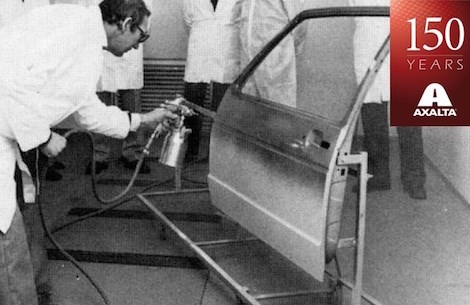Axalta Celebrates 150 Years in Coatings
First products developed in Germany in 1866, and since has grown into one of the world’s leading manufacturers of liquid and powder coatings.

Axalta Coating Systems is celebrating 150 years of creating innovative industrial coatings. Axalta’s first products were developed in Germany in 1866, and since then the company has grown into one of the world’s leading manufacturers of liquid and powder coatings.
“All of us at Axalta are excited to reach this important milestone in the history of our company,” said Axalta Chairman and CEO Charlie Shaver. “Over the next 12 months we will celebrate our past and build on our extensive knowledge and experience for the next 150 years. With nearly 13,000 employees and 120,000 customers in 130 countries, we will continue to use advanced technologies to develop next generation coatings while providing outstanding quality and service in the years ahead.”
From the earliest products that supplied European carriage manufacturers with colorful coatings in the nineteenth century, Axalta evolved to meet the needs of an automotive industry that flourished in the twentieth century. In the 1920s, Axalta introduced the first quick drying multi-color lacquer line for automobile production in the U.S. Company scientists developed the L,a,b color equations that became a key analytic tool in the catalogue of color science. In the subsequent decades, technology at Axalta evolved to produce coatings that were increasingly durable and productive. In the 1980s, the company ushered in the first environmentally responsible liquid coating systems with the introduction of waterborne coatings.
Building on experience acquired with its original Spies Hecker and Standox products, Axalta branched out to provide refinish technicians with improved coating products and systems. In the 1990s, the Cromax family of waterborne products was introduced to automotive body shops. Handheld spectrophotometers and VINdicator™ color tools were developed to help provide excellent color matching which saves repair time and reduces waste.
As the need across many industries evolved, so did Axalta’s portfolio of products. To serve a growing number of industrial customers, Axalta introduced Nap-Gard powder coatings for oil and gas pipeline manufacturers. Today, both functional coatings and a wide array of decorative Alesta powder coatings are used in thousands of applications. Voltatex electrical insulation coatings enhance the productivity of motors and a host of electrical components. Vehicles ranging from heavy duty trucks and buses to trains and other rail stock rely on Imron to protect their vehicles from the elements while using vibrant colors to build recognition for their brands.
“We have been expanding both the global capabilities and global reach of Axalta,” added Shaver. “We have accelerated our investments to expand production capacity in Germany, Brazil, China, Mexico and India. We announced construction of a new Global Innovation Center in Philadelphia, PA and began construction of an Asia-Pacific technology center in China that will keep our technology at the cutting edge. We’ve taken strong regional brands and introduced them globally. All of these measures, plus the many advances we are making in color technology, are focused on meeting the needs of our customers well into the future.”
Related Content
-
NASF/AESF Foundation Research Project #122: Electrochemical Approaches to Treatment of PFAS in Plating Wastewater - 7th Quarterly Report
The NASF-AESF Foundation Research Board has selected a project on addressing the problem of PFAS and related chemicals in plating wastewater streams, studying PFAS destruction via electrooxidation and electrocoagulation. Our last report described the results from experiments of EO with a Magnéli phase Ti4O7 anode on the degradation of eight perfluoroalkyl acids (PFAAs). In this seven quarter report, we describe work to further explore how the degradation of different PFAAs are related to their molecular structures.
-
NASF/AESF Foundation Research Project #122: Electrochemical Approaches to Treatment of PFAS in Plating Wastewater - 10th Quarterly Report
The NASF-AESF Foundation Research Board selected a project addressing the problem of PFAS and related chemicals in plating wastewater streams. This report covers the 10th quarter of work (April-June 2023). Here, we examine the effect of surface fluorination of Ti4O7 anodes on PFAS degradation performance in terms of energy performance as well as formation of chlorate and perchlorate when chloride is present in the solution. The full paper on this work can be accessed and printed at short.pfonline.com/NASF24Feb2.
-
Explore Cleaning Chemistry, Metal Finishing Applications and Wastewater Treatment Solutions
Hubbard-Hall Celebrating 175 years of excellence, Hubbard-Hall presents chemistry and equipment.













.jpg;maxWidth=300;quality=90)

